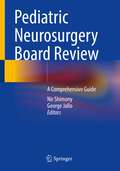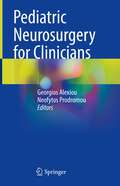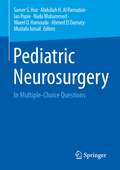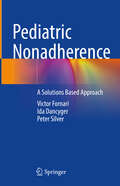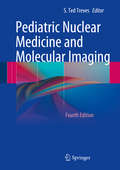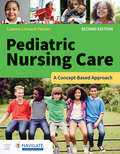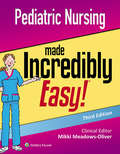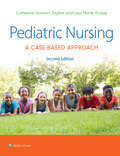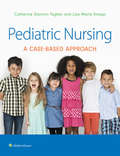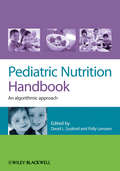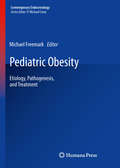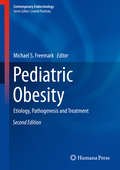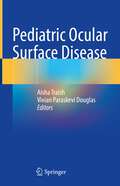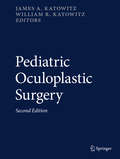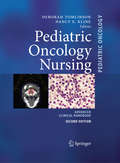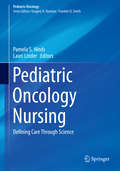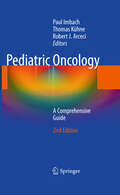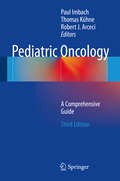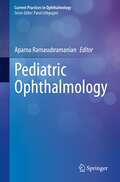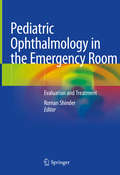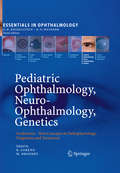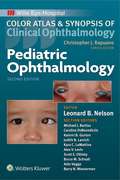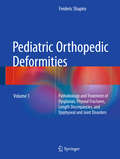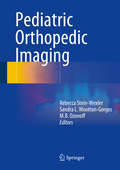- Table View
- List View
Pediatric Neurosurgery Board Review: A Comprehensive Guide
by George Jallo Nir ShimonyThis specialized textbook will be dedicated to the various disease topics of pediatric neurosurgery and management strategies. The text will cover the different aspects of the field of pediatric neurosurgery in a unique way by giving state of the art up-to-date synopsis with references to recent publications. More specifically, the whole book is dedicated to a comprehensive discussion of brainstem tumors and other lesions. It will be composed of 20 chapters. The various chapters will start from updates regarding the development of the nervous system and the clinical differences in assessing the infant or a child in comparison to the adult patient. The book then will focus on various pathologies starting with hydrocephalus, pediatric brain and spine tumors, congenital malformation, spasticity, epilepsy, and more. The proposed textbook will be enriched with diagnostic and surgical images, and illustrations that cover all types of pediatric neurosurgery pathologies, with an emphasis on evidence-based data that reflects the controversies and possible solutions. The main structure of each chapter will include a short synopsis of the topic at hand, questions and answers that will inspire the reader for better understanding, learning objectives, and key references for further reading. Written by experts in the field, Pediatric Neurosurgery Board Review serves as a valuable resource for neurosurgery residents and fellows studying for their neurosurgery exams, as well as an educational material for neurosurgery specialists after graduation by discussing pediatric neurosurgery in more convenient way to review and understand key information in this field.
Pediatric Neurosurgery for Clinicians
by Georgios Alexiou Neofytos ProdromouThis book presents a detailed overview of a spectrum of pediatric neurosurgical conditions. It features detailed insight into the techniques available for examining abnormalities, hemorrhages and a variety of tumors. Relevant surgical methodologies are described in relation to a clinical problem or disorder, ensuring that the reader can systematically develop their knowledge of how to perform both routine and more-obscure procedures presently utilized to treat these conditions. Pediatric Neurosurgery for Clinicians is a comprehensive guide detailing methodologies for applying a range of surgical techniques based upon a range of clinical questions. Therefore, it is a critical resource for all practicing and trainee physicians who encounter children with disorders affecting their neurological systems in disciplines within neurosurgery, neurology, radiology, oncology and pathology.
Pediatric Neurosurgery: In Multiple-Choice Questions
by Samer S. Hoz Mustafa Ismail Abdullah H. Al Ramadan Ian Pople Nada Mohammed Waeel O. Hamouda Ahmed El DamatyThis book is the first review book to use the multiple-choice question format in pediatric neurosurgery. More than 500 MCQs are provided in a convenient format that is suitable for self-study.The mission of the book is to help readers understand the content and maintain the knowledge, rather than merely finding answers for complicated questions. The strategy and the format of the questions provide a step-by-step, thorough explanation of each disease from the definition, associated anatomy, pathology, clinical features, radiology to surgical decision-making, and surgical tricks, providing a comprehensive and concise overview. Answers and definitions appear immediately below the questions to facilitate information retention. It is an important asset for residents across neurosurgical disciplines as it includes much of the pediatric neurosurgery knowledge that neurosurgical residents need to prepare for their certification tests. It is also useful for those seeking ways to solidify their knowledge or maintain their current certification. This book is an adjunct to the existing texts and does not intend to be the primary source of information; it rather aims to help readers identify their relevant strengths and weaknesses in the area.
Pediatric Nonadherence: A Solutions Based Approach
by Peter Silver Victor Fornari Ida DancygerNonadherence to pediatric recommendations is a pervasive challenge to the growth, development, and wellbeing of children. Nearly half of all youth and their parents suffer the consequences of misunderstanding, forgetting, ignoring or refusing professional medical advice regarding children. Addressing this widespread dilemma, this unique and comprehensive title explores a variety of different pediatric problems that impact children, adolescents and their families. Clinical case vignettes are provided to highlight particular considerations, and a description of the most up-to-date strategies to solve the dilemma of nonadherence to pediatric care is provided. Indeed, technology is emphasized as an important and innovative means of tracking, interfacing and gathering individual data and facilitating improved pediatric adherence. No one intervention strategy can be applied to solve nonadherence of pediatric patients. Research studies have concluded that successful efforts to enhance adherence rely on a number of important elements. First and foremost is nurturing a trusting relationship between the patient, the family and the clinician, which strengthens the therapeutic alliance. Following that is making sure that the patient and family fully understand the nature of the illness and the recommendations. Effective and clear communication is critical between the health professionals, the patient and the family. When the health professional understands who the patient and the family are on a deeper level, then adherence may be improved. It is imperative that the clinicians take into account the individual patient and families’ cultural, social and community context, as well as their beliefs and support systems. An atmosphere of shared collaboration and mutual respect will improve open communication and the promotion of adherence and positive outcomes. An important thread throughout each chapter is the impact of health care disparities, diversity and equity. The contributors to Pediatric Nonadherence represent a wide range of nationally and internationally recognized experts in their area of pediatric sub-specialization and practice. A major contribution to the clinical literature, this timely title will be of great interest to pediatricians, family practitioners, medical students, residents, fellows, physician assistants, and nurse practitioners.
Pediatric Nuclear Medicine and Molecular Imaging
by S. Ted TrevesThis pioneering book, now in its fourth edition, presents the cutting-edge developments in pediatric nuclear medicine. Thoroughly revised and updated, it retains the fundamentals that anchor the book's distinguished reputation and includes the latest advances in PET/CT, SPECT, hybrid imaging, and molecular imaging. Pediatric Nuclear Medicine and Molecular Imaging, Fourth Edition, is an excellent resource for nuclear medicine physicians, diagnostic radiologists, pediatricians, and residents and fellows. The Fourth Edition features: · 16 new chapters, including PET and PET/CT in Children and Young Adults; Lymphoscintigraphy; Skeletal Scintigraphy; Neuroblastoma; Lymphomas and Lymphoproliferative Disorders; Functional Imaging of Pediatric Musculoskeletal Tumors; Solid Tumors in Childhood; Pediatric Molecular Imaging; Combined PET/MRI in Childhood; Radiation Exposures; Radiation Protection in Pediatric Nuclear Medici≠ and Dose Optimization in Pediatric Nuclear Medicine. · Discussion of the use of image fusion and hybrid imaging in children. · Strategies for communicating potential radiation risk to patients, families and members of the healthcare team. · Methods to optimize pediatric radiopharmaceutical administered doses and improve image quality. S. Ted Treves, MD, is Professor of Radiology at Harvard Medical School, Founder and Former Chief, Division of Nuclear Medicine and Molecular Imaging, Ch ildren's Hospital Boston (1970-2011). In 2013, he received the Society of Nuclear Medicine and Molecular Imaging's Georg Charles de Hevesy Nuclear Pioneer Award for outstanding contributions to the field of Nuclear Medicine.
Pediatric Nursing Care: A Concept-Based Approach
by Luanne Linnard-PalmerPediatric Nursing Care: A Concept-Based Approach, Second Edition provides pre-licensed nursing students the need-to-know information for working as a pediatric nurse in a variety of settings. The concept-based perspective, information on pathologies and diagnoses unique to children, and focus on family-centered care set it apart from other pediatric nursing textbooks. The Second Edition was updated to offer the latest information on family education, current research, safety, and pharmacology. Chapters unique to this text include those focusing on symptoms assessment and management for children, working and communicating in interdisciplinary teams, caring for children across healthcare settings, cultural care models, essential safety models, and pediatric-specific skills. Pediatric Nursing Care: A Concept-Based Approach, Second Edition is a helpful guide and reference for attaining a deeper understanding of the unique aspects of pediatric nursing.
Pediatric Nursing Made Incredibly Easy: Made Incredibly Easy
by Mikki Meadows-OliverCreate a strong foundation in pediatric nursing care — and gain empowering skills and confidence — with the fully updated Pediatric Nursing made Incredibly Easy!®, 3rd Edition. This fully illustrated, enjoyable guide offers easy-to-remember ways to strengthen your understanding and retention of common pediatric conditions at every level of child development. An irreplaceable on-the-job reference for all new nurses, this go-to resource supports class materials, is the ideal study partner for NCLEX®, HESI or CPN exam preparation, and is an excellent refresher for experienced nurses.
Pediatric Nursing: A Case-Based Approach
by Catherine Gannon Tagher Lisa Marie KnappPediatric Nursing: A Case-Based Approach, 2nd Edition, helps students master pediatric nursing concepts and develop the critical thinking and clinical judgment essential to safe pediatric care and health promotion for children of all ages. This extensively updated 2nd Edition details the latest pediatric approaches to COVID-19, child abuse, mental health, and more, accompanied by new learning features that train students to think like nurses and prepare for the Next-Generation NCLEX®. Realistic clinical scenarios challenge students to apply their understanding, reinforcing key content while honing the clinical reasoning, patient advocacy, and patient education skills critical to effective outcomes in any setting.
Pediatric Nursing: A Case-Based Approach (Prepu Series)
by Gannon Tagher Lisa KnappImmerse Yourself in the Role of a Pediatric Nurse Develop the clinical judgment and critical thinking skills needed to excel in pediatric nursing with this innovative, case-based text. Pediatric Nursing: A Case-Based Approach brings the realities of practice to life and helps you master essential information on growth and development, body systems, and pharmacologic therapy as you apply your understanding to fictional scenarios based on real clinical cases throughout the pediatric nursing experience. Accompanying units leverage these patient stories to enrich your understanding of key concepts and reinforce their clinical relevance, giving you unparalleled preparation for the challenges you’ll face in your nursing career. Powerfully written case-based patient scenarios instill a clinically relevant understanding of essential concepts to prepare you for clinicals. Nurse’s Point of View sections in Unit 1 help you recognize the nursing considerations and challenges related to patient-based scenarios. Unfolding Patient Stories, written by the National League for Nursing, foster meaningful reflection on commonly encountered clinical scenarios. Let’s Compare boxes outline the differences between adult and pediatric anatomy and physiology. Growth and Development Check features alert you to age and developmental stage considerations for nursing care. The Pharmacy sections organize medications by problem for convenient reference. Whose Job is it Anyway? features reinforce the individual responsibilities of different members of the healthcare team. Analyze the Evidence boxes compare conflicting research findings to strengthen your clinical judgment capabilities. How Much Does It Hurt? boxes clarify the principles of pediatric pain relevant to specific problems. Hospital Help sections alert you to specific considerations for the hospitalization of pediatric patients. Priority Care Concepts help you confidently assess patients and prioritize care appropriately. Patient Teaching boxes guide you through effective patient and parent education approaches. Patient Safety alerts help you quickly recognize and address potential safety concerns. Interactive learning resources, including Practice & Learn Case Studies and Watch & Learn Videos, reinforce skills and challenge you to apply what you have learned. Learning Objectives and bolded Key Terms help you maximize your study time. Think Critically questions instill the clinical reasoning and analytical skills essential to safe patient-centered practice. Suggested Readings point you to further research for more information and clinical guidance.
Pediatric Nutrition Handbook
by David Suskind Polly LenssenThe last decade has seen an explosion of medical information in regards to the nutrition care and management of children. While nutritional therapies have expanded, the treatment choices have become increasingly complex. This exciting title addresses the extensive amount of information available to practitioners in a concise, accessible fashion via a series of algorithms. It focuses on the normal growing healthy child from birth through adolescence, covering common pediatric diseases and disorders through a series of flows charts which outline step-by-step nutritional processes for pediatric patients. The highly visual format of the book allows the practitioner to make rapid, evidence based choices.Features:Unique algorithm approach to the largest dietetic specialism Highly visual approach allows quick decision making All algorithms and text built on evidence-based research Covers the pediatric phase from birth to adolescence Includes common childhood diseases and disorders
Pediatric Obesity
by Michael FreemarkChildhood obesity and its co-morbidities -- including type 2 diabetes, hypertension, dyslipidemia, sleep apnea, and fatty liver disease -- have seen striking increases in recent years. Despite a wealth of investigation, there is considerable controversy regarding the etiology of childhood obesity and the optimal approaches for prevention and treatment. Pediatric Obesity: Etiology, Pathogenesis, and Treatment addresses the controversy with a range of features that make it a unique resource for those who care for obese children and their families. Written from a perspective that is international in scope, the distinguished authors re-assess the roles of genetic and environmental factors in the pathogenesis of childhood obesity and critically review new studies of the effects of lifestyle, pharmacologic, and surgical interventions. The evidence-based approach of Pediatric Obesity: Etiology, Pathogenesis, and Treatment provides a comprehensive and invaluable guide for all healthcare providers concerned with the evaluation and care of children with nutritional and metabolic disease and with the societal implications of the obesity epidemic.
Pediatric Obesity
by Michael S. FreemarkChildhood obesity and its co-morbidities -- including type 2 diabetes, hypertension, dyslipidemia, sleep apnea, and fatty liver disease -- have seen striking increases in recent years. Despite a wealth of investigation, there is considerable controversy regarding the etiology of childhood obesity and the optimal approaches for prevention and treatment. Pediatric Obesity: Etiology, Pathogenesis, and Treatment addresses the controversy with a range of features that make it a unique resource for those who care for obese children and their families. Written from a perspective that is international in scope, the distinguished authors re-assess the roles of genetic and environmental factors in the pathogenesis of childhood obesity and critically review new studies of the effects of lifestyle, pharmacologic, and surgical interventions. The evidence-based approach of Pediatric Obesity: Etiology, Pathogenesis, and Treatment provides a comprehensive and invaluable guide for all healthcare providers concerned with the evaluation and care of children with nutritional and metabolic disease and with the societal implications of the obesity epidemic.
Pediatric Occupational Therapy Handbook: A Guide to Diagnoses and Evidence-based Interventions
by Patricia Bowyer Susan M. CahillCombining essential assessment guidance with the latest evidence-based intervention strategies, this compact reference helps you quickly locate the information you need to evaluate and manage pediatric disorders. <p><p>Access diagnosis-specific information on epidemiology, precautions, and more, as well as suggested interventions supported by the latest research, all in a convenient, pocket-sized handbook perfect for the busy clinical setting. Information is presented in a consistent format for easy reference and complies with the OT Practice Framework to help you ensure the most effective therapeutic outcomes.
Pediatric Ocular Surface Disease
by Aisha Traish Vivian Paraskevi DouglasOcular surface diseases in children have not always been well understood and the literature in this age group is limited. The consequences of misdiagnosis and delayed diagnosis include visually significant scarring and amblyopia, thus with real impact on their quality of life and ultimate visual potential. Recently, there has been an increase in clinical and research focus on these diseases, contributing to a growing awareness of their importance to pediatric visual health. This book is the first comprehensive volume dedicated to pediatric ocular surface diseases. It provides an up-to-date and highly illustrated discussion of the pathophysiology, symptomatology and diagnostic and therapeutic strategies of these less commonly understood diseases, in a format that is readily absorbed by trainees and seasoned physicians alike. The aim of this book is to provide a practical and detailed understanding of ocular surface disease in the pediatric population, as many of these corneal conditions in children require unique therapeutic approaches and may have subtle presentations. Chapters will address key issues, such as dry eye disease, Steven Johnson Syndrome and neurotrophic keratitis, that can have a profound impact on children’s visual and social development. Pediatric Ocular Surface Disease is a must-have resource for pediatric ophthalmology fellows, cornea fellows, pediatric ophthalmologists, and cornea specialists.
Pediatric Oculoplastic Surgery
by James A. Katowitz William R. KatowitzThis well-illustrated book presents the latest diagnostic concepts and management techniques in the rapidly expanding subspecialty of pediatric oculofacial plastic surgery. Covering all aspects of the field and taking into account numerous surgical innovations and exciting new medical treatment concepts that have emerged since publication of the previous edition in 2002, Pediatric Oculoplastic Surgery, 2nd Edition will prove to be an invaluable resource for both the comprehensive ophthalmologist and the subspecialist with a particular interest in pediatric disorders of the eyelids, orbit, and nasolacrimal system. Topics discussed, in addition to clearly illustrated basic oculoplastic procedures, include surgical innovations ranging from the Sonopet system for safer removal of bone in lacrimal surgery to the development of complex image guidance technology for sinus and orbital surgery. Detailed discussion of syndromic and non-syndromic congenital anomalies explore a variety of surgical techniques and the nuances of applying these approaches in the management of various structural abnormalites. Further important advances include new analytic laboratory techniques, which can illuminate the genetic basis of many pediatric oculoplastic disorders, various medical management advances such as the role of beta blockers in the treatment of facial and orbital hemangiomas, and the development of biologic pathway blockers inhibiting tumor growth which offer real potential for reducing the necessity of surgical intervention.
Pediatric Oncology Nursing
by Nancy E. Kline Deborah TomlinsonThis is the second edition of a comprehensive clinical handbook for nurses in pediatric hematology/oncology that presents in-depth information on pathophysiology, diagnosis, treatment, advanced assessment, and interventions. All chapters have been updated since the first edition, and additional chapters have been included where necessary. The book is divided into five sections: pediatric cancers, hematologic disorders, treatment of childhood cancer, side-effects of treatment and disease, and supportive and palliative care. It is organized in a consistent and accessible format with quick reference guides that will prove invaluable in everyday practice. All of the authors are pediatric experts from the United Kingdom and North America, and their contributions reflect their diverse backgrounds and experiences. This handbook will provide an indispensable tool for those responsible for the clinical nursing care of children with cancer, and assist in meeting the many challenging developments in this specialty.
Pediatric Oncology Nursing: Defining Care Through Science (Pediatric Oncology)
by Pamela S. Hinds Lauri LinderThis book presents the current state of the nursing science in topics relevant to the care of pediatric oncology patients and their families across the treatment trajectory and is framed within a precision health framework. The spectrum of topics covered is wide, including, for example, symptom management, self-care management, exercise and physical activity, family-centered care, palliative care, the role of the nurse in treatment decision making, patient and nurse resiliency, survivorship, and genetic counseling. Throughout, there is a focus on the implications of research for nursing practice, highlighting which elements of the available evidence are ready for translation into practice and which are not. In addition, careful attention is paid to the role that nursing can play in further advancing science through clinical research. The authors are leading experts from across the globe. The book will be of special interest for pediatric oncology nurses, including direct care nurses, research nurses, and nursing leaders, and will also be a stimulating source for researchers and non-oncology nurses.
Pediatric Oncology, 2nd Edition
by Thomas Kühne Robert J. Arceci Paul ImbachThis is the second edition of a well-received compendium of information and guidance on the diagnosis and management of the various oncological diseases that are encountered in children and adolescents. For each disease entity, fundamental facts are provided that will be relevant for a range of professionals - hospital physicians, specialist nurses, psycho-oncologists, physiotherapists, family doctors, and pediatricians. Compared with the first edition, all chapters have been updated and entirely new chapters are included on rare disorders, genetic aspects, and palliative care. Throughout, rapid orientation is ensured by the clear, consistent layout and the concise, lucid style. Pediatric Oncology: A Comprehensive Guide is an excellent, easy-to-use reference that belongs on the shelf of every practitioner who encounters or treats malignancies in the pediatric age group.
Pediatric Oncology, 3rd Edition
by Thomas Kühne Robert J. Arceci Paul ImbachThis is the third edition of a well-received compendium of information and guidance on the diagnosis and management of the various oncological diseases that are encountered in children and adolescents. In the new edition a chapter on Rare Tumors was added. For each disease entity, fundamental facts are provided that will be relevant for a range of professionals – hospital physicians, specialist nurses, psycho-oncologists, physiotherapists, family doctors and pediatricians. Compared with the first edition all chapters have been updated. Throughout, rapid orientation is ensured by the clear, consistent layout and the concise, lucid style. Pediatric Oncology: A Comprehensive Guide is an excellent, easy-to-use reference that belongs on the shelf of every practitioner who encounters or treats malignancies in the pediatric age group. Pediatric Oncology is teamwork! Fundamental facts for all those involved in diagnosis and management – even social worker, pedagogic teachers, religious care persons.
Pediatric Ophthalmology (Current Practices in Ophthalmology)
by Aparna RamasubramanianThe book provides a comprehensive review of the current trends in pediatric ophthalmology. It covers well-researched and up-to-date information and keeps the readers updated with the current literature. Pediatric ophthalmology is a vast area with multiple subspecialties and the book helps streamline the literature for rapid reference. The editors and authors are experts in the field. The book is helpful for the general ophthalmologist, ocular oncologist, ophthalmology residents and fellows in training optometrists.
Pediatric Ophthalmology in the Emergency Room: Evaluation and Treatment
by Roman ShinderThis book aims to cover the important pediatric ophthalmic diagnoses that present in the emergency room. A collaborative work of experienced experts, it describes the history, examination, testing, epidemiology, pathogenesis, treatment, and prognosis for a variety of disorders. Richly illustrated, the book off ers an invaluable tool for all specialists and trainees entrusted with the care of children presenting with ocular conditions.Across 17 comprehensive yet concise chapters, this book provides an overview on a number of typical pathologies, including trauma, infections, inflammations, and tumors. Organized into five sections, each chapter is written to relay broad insight into the common ophthalmic conditions that may bring a child in for an acute healthcare visit. Additionally, skillfully written text is further supplemented by many high-quality images, including clinical photographs, fundus images, radiographs, and intraoperative photos. Pediatric Ophthalmology in the Emergency Room meets the market need for a resource on this specific topic designed for trainee instruction. It is a valuable text for medical students, residents, and fellows, as well as anyone involved in the urgent or emergent care of children, including ER physicians, ophthalmologists, optometrists and other personnel.
Pediatric Ophthalmology, Neuro-Ophthalmology, Genetics
by Michael C. Brodsky Birgit LorenzThe 8 recurring volumes of the "Essentials in Ophthalmology" series cover the most recent developments in one of eight subspecialties in Ophthalmology. With four volumes published per year, each subspecialty is newly visited every 24 months, with a distinct focus on recent developments. By bridging the gap between original research and medical textbooks, the transfer of this developing knowledge into daily practice is greatly enhanced.
Pediatric Ophthalmology: A Text Atlas (Color Atlas and Synopsis of Clinical Ophthalmology)
by Leonard NelsonPublisher's Note: Products purchased from 3rd Party sellers are not guaranteed by the Publisher for quality, authenticity, or access to any online entitlements included with the product. Developed at Philadelphia’s world-renowned Wills Eye Hospital, the Color Atlas and Synopsis of Clinical Ophthalmology series covers the most clinically relevant aspects of ophthalmology in a highly visual, easy-to-use format. Vibrant, full-color photos and a consistent outline structure present a succinct, high-yield approach to the seven topics covered by this popular series: Cornea, Retina, Glaucoma, Oculoplastics, Neuro-Ophthalmology, Pediatrics, and Uveitis. This in-depth, focused approach makes each volume an excellent companion to the larger Wills Eye Manual as well as a practical stand-alone reference for students, residents, and practitioners in every area of ophthalmology.
Pediatric Orthopedic Deformities, Volume 1
by Frederic ShapiroDevelopmental biology of normal bone and cartilage including histogenesis, molecular/gene and biomechanical aspects is updated and expanded. The book outlines the biology of: bone repair with differing mechanical environments; cartilage repair at articular and physeal sites; and distraction osteogenesis. The generously illustrated text provides an in-depth presentation of the interplay between normal developmental biology, abnormal pathologic states and the influence of operative and non-operative orthopedic interventions on childhood orthopedic deformity. Thirty-four principles underlying the development, progression and management of skeletal deformity in the growing child are defined. Orthopedic management including surgical treatment is discussed for: skeletal dysplasias; epiphyseal growth plate fracture-separations; lower extremity length discrepancies; and deformities of joints and epiphyses due to metabolic, inflammatory, infectious, hematologic, and neoplastic disorders. Treatments are related to extent of deformity, remodeling post-surgery and possible recurrence. This 2nd edition of Pediatric Orthopedic Deformities has been expanded to cover more regions and disorders and is being presented in 3 volumes.
Pediatric Orthopedic Imaging
by Rebecca Stein-Wexler Sandra L. Wootton-Gorges M. B. OzonoffThis book is an indispensable reference for pediatric and musculoskeletal radiologists, as well as orthopedic surgeons. It offers in depth analysis of pediatric orthopedic imaging, covering normal and aberrant development as well as both common and unusual pediatric disorders. Chapters on the spine, shoulder, elbow, hand and wrist, hip and pelvis, lower extremity, and foot and ankle address site-specific congenital and acquired lesions. Subsequent chapters cover generalized orthopedic diseases such as neurofibromatosis and osteogenesis imperfecta, infectious processes, neuromuscular diseases, musculoskeletal tumors, trauma, and orthopedic procedures. The chapters review associated epidemiology, clinical presentation and evolution, treatment, and differential diagnoses, with in-depht analysis of imaging characteristics. With more than 1800 images, high-quality MRI, CT, and US examples complement the radiographs of a broad variety of musculoskeletal disorders.
